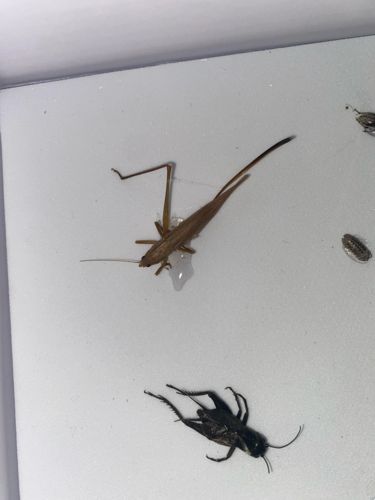Field Cricket (black) and possibly a Katydid or Bush Cricket (tan)
Scientific Name: Gryllus (for Field Cricket), Tettigoniidae (for Katydid/Bush Cricket)
Order & Family: Order Orthoptera, Family Gryllidae (for Field Cricket), Order Orthoptera, Family Tettigoniidae (for Katydid/Bush Cricket)
Size: Field Crickets: 13-25 mm (0.5-1 inch) in length. Katydids/Bush Crickets: Can vary greatly, from 1-7 cm (0.4-2.8 inches), some species even larger.

Natural Habitat
Field Crickets: Grasslands, meadows, fields, cultivated areas, frequently found near homes and buildings, often hiding under rocks, logs, or debris. Katydids/Bush Crickets: Forests, grasslands, shrubs, and trees, often well-camouflaged among foliage.
Diet & Feeding
Field Crickets (omnivorous): Primarily feed on plants, seeds, and decaying organic matter, but will also eat small insects or carrion. Katydids/Bush Crickets (mostly omnivorous or herbivorous): Many species feed on leaves, flowers, bark, and seeds, while some are predatory, eating other insects.
Behavior Patterns
Field Crickets are known for their chirping, produced by males rubbing their wings together to attract mates. They are typically nocturnal. Katydids/Bush Crickets are also known for their long antennae and stridulation (sound production), often at night, which can range from chirps to buzzing or clicking sounds. They are excellent at camouflage.
Risks & Benefits
Risks: Field Crickets can be a nuisance when they enter homes in large numbers and their chirping can be loud. They can damage seedlings or garden plants if populations are high. Benefits: Both crickets and katydids serve as a food source for various predators (birds, reptiles, small mammals) and can help with decomposition. Some katydids are also important pollinators.
Identified on: 9/17/2025